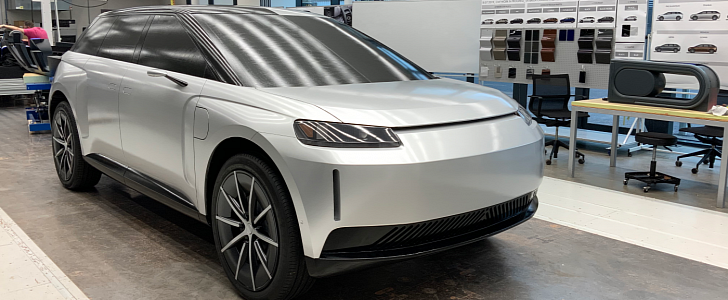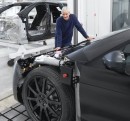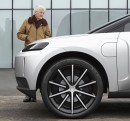Sir James Dyson is the richest man in the UK and the founder of Dyson Ltd, best known for its vacuums and hair-driers. For a very short time, Dyson was also an electric car maker, even though you may not have known about it.
In mid-May this year, many months after the project was officially axed, Sir Dyson spoke for the first time in great detail about the Dyson EV, aka N526, the first electric SUV Dyson was going to make on the proprietary platform it had developed in-house. Now, he’s offering even more words, photos and videos of what would have been, as he puts it, a “radical,” extremely elegant and highly efficient car.
The reason Dyson has not been seen in public light – and will never be – is that it was eventually deemed not commercially viable. After developing the prototype at the Hullavington Airfield facility dedicated to the project, it was determined that each car would have had to sell for upwards of £150,000 ($189,000) just to break even, as we reported in a previous article.
Price aside, it would have been a great car, Sir Dyson says. It was “radical” and “loaded with technology,” and “solved a lot of problems that are traditionally associated with electric vehicles.” He doesn’t exactly go into specifics on either claim, but presumably range anxiety would have been one such problem: the Dyson would have boasted a (theoretical) range of 600 miles (966 km).
Dyson would have had “bespoke, integrated and highly efficient Electric Drive Unit (EDU) comprising Dyson digital electric motor, single speed transmission and state of the art power inverter,” delivered 536 hp and a top speed of 125 mph (201 kph). It would have also placed plenty of emphasis on comfort and functionality.
With a longer wheelbase, the N526 would have had improved interior space, with everything inside central to the driver. Structural seats with posture support came to replace the armchair-style seats found in most passenger vehicles, which Dyson personally doesn’t like, and all the controls were placed on the steering wheel instead of on the dashboard. Proprietary air filtration technology controlled the environment and purified the air.
The Dyson was meant to be a sporty-looking SUV that delivered both in terms of looks and comfort, and efficiency. Asked whether he’d do anything different about it if he could, Sir Dyson says he wouldn’t change a thing – except not start the project at all. Dyson himself spent £500 million ($630 million) out of pocket on the stillborn EV and the lesson he learned is that EVs are expensive to make because of battery costs.
The reason Dyson has not been seen in public light – and will never be – is that it was eventually deemed not commercially viable. After developing the prototype at the Hullavington Airfield facility dedicated to the project, it was determined that each car would have had to sell for upwards of £150,000 ($189,000) just to break even, as we reported in a previous article.
Price aside, it would have been a great car, Sir Dyson says. It was “radical” and “loaded with technology,” and “solved a lot of problems that are traditionally associated with electric vehicles.” He doesn’t exactly go into specifics on either claim, but presumably range anxiety would have been one such problem: the Dyson would have boasted a (theoretical) range of 600 miles (966 km).
Dyson would have had “bespoke, integrated and highly efficient Electric Drive Unit (EDU) comprising Dyson digital electric motor, single speed transmission and state of the art power inverter,” delivered 536 hp and a top speed of 125 mph (201 kph). It would have also placed plenty of emphasis on comfort and functionality.
With a longer wheelbase, the N526 would have had improved interior space, with everything inside central to the driver. Structural seats with posture support came to replace the armchair-style seats found in most passenger vehicles, which Dyson personally doesn’t like, and all the controls were placed on the steering wheel instead of on the dashboard. Proprietary air filtration technology controlled the environment and purified the air.
The Dyson was meant to be a sporty-looking SUV that delivered both in terms of looks and comfort, and efficiency. Asked whether he’d do anything different about it if he could, Sir Dyson says he wouldn’t change a thing – except not start the project at all. Dyson himself spent £500 million ($630 million) out of pocket on the stillborn EV and the lesson he learned is that EVs are expensive to make because of battery costs.











